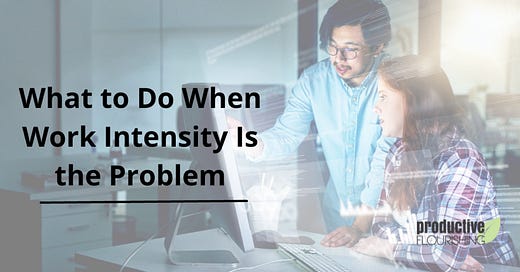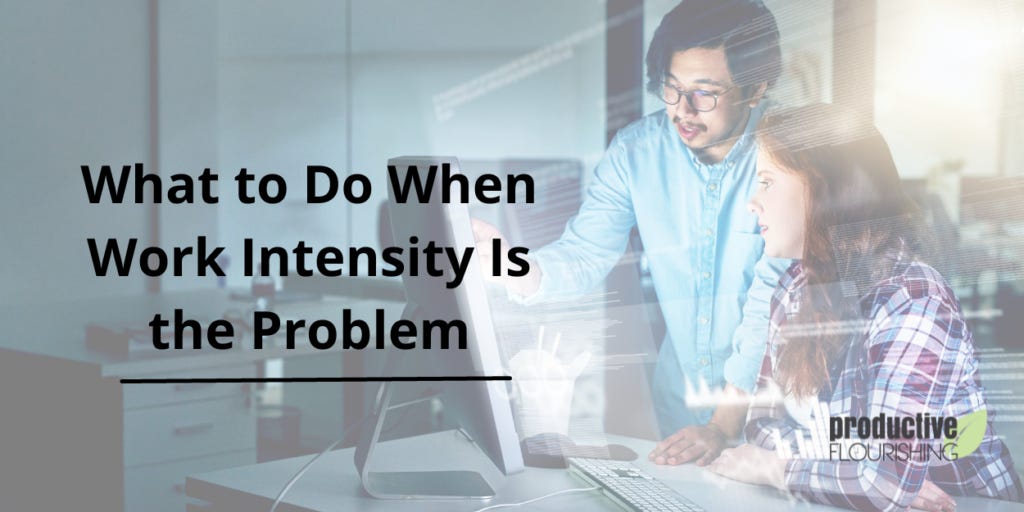What to Do When Work Intensity Is the Problem
Working fewer hours can backfire and lead to more stress and burnout.
Depending on how you try to work fewer hours a day, you could actually be making your work and life worse. A client recently wanted to problem-solve for working four days a week, but when she started explaining her reasoning, it wasn’t about the load of her days or how many days a week she worked.
Deep down it was about work intensity and how stressful it was for her to be working “at 100% efficiency” for 5-6 hours a day. I pointed out that a really common pattern, and a byproduct of efficiency crankers, is they’re exhausted no matter how much actual work is on their plate.
Even if/when we remove 25% of the work from their plate, the typical move among these folks is to then cut the amount of time they give themselves to do the work by 25%. This has the net result of them being just as stressed about the work, no matter how much work is removed from their plate.
I should add: an additional part of this client’s scenario is, partly because of the work we’ve done together, many things are going really well for her right now. Her business is working well, she’s getting the right clients, and she loves the work that she does. She has a new good-for-her romantic partner. Her health is great and much better than when we started.
She’s happy and doesn’t want much, which itself has become a challenge for her. (We’re working through the way her upper limit responses have gone guerrilla.) In her circumstances, cutting an additional day of work wouldn’t necessarily make her better off — and could create a lot of stress to get there. She’d end up working four days, at an even higher intensity, and end up just as worn out.
Instead of Working Faster, Live More Slowly
Instead of cutting work, I asked her “What would you do if I asked you to be 15% slower?” We brainstormed a few “slow practices,” she might do in 5-10 minutes, like:
Take a stretch break
Drink water
Walk around the block
Read a selection from a book
Snuggle with her cat
Meditate
Focus on breathing
She’s still exploring whether it’ll be best for her personally to set a timer to initiate her slow practices and self-care or to sense when she needs to do one of these practices between tasks. The latter is better for most people after they have been practicing slow productivity for a while, but when folks are addicted to checking off tasks, it’s typically better to start with timers.
On the subject of timers, I happen to know she uses timers for her work. I reminded her that if she could use her timers to work, she could use timers to not work.
The obvious difference is that, in the latter case, she’d have to give herself permission to stop working. For her, it’s going to take more discipline for her to use her slow practices than to crunch and crank.1
This is one of those cases where my normal go-tos of subtraction do not work well. Adding some recovery practices to her day will create more vitality, joy, creativity, and richness in her work and life. Working an hour or day less at the same pace would not get her there.
The Four-Day Work Week Can Amplify Work Intensity
We see many organizations who fumble this, too. Their response to burnt-out, overloaded workers is to switch to 4 days a week, but for many workers, that amounts to having to do the same amount of work in less time — it increases intensity without really addressing the workways and team habits creating more work than people can do in their compensated time.
What really needs to be solved for is the load of work, not just the number of days people work.
A 4-day work week boiled down to 10 hours of work a day can in some cases be a good solution for companies. For example, if someone commutes for an hour or ninety minutes per day, the additional day off makes a real difference.
These same companies would likely see a better result if they encouraged workers to do admin or remote work from home on Friday, or, better yet, to let teams decide when they need to work remotely and when they need to be co-located. No one wants to commute to do the same things they can do from home and many people wouldn’t mind the commute as much if the work they were driving to do really got done better face-to-face or co-located.
The Two Mindsets That Create the Intensity Problem
What we really need to consider, though, is the mindset that causes people to work so intensely in the first place. Sometimes it’s what it takes to get the job done but other times, there are more insidious things at play.
The following are two more common reasons for the intensity, though:
Anxiety: When people have anxiety about open tasks, there’s pressure to close the tasks out, even if they’re harming themselves in the process. Checking off tasks becomes a dopamine hit and to get as many hits as they can, they crunch the amount of work down to as little time as possible, which has the effect of creating anxiety to relieve anxiety. Yes, it’s absurd when said out loud, but it’s a dynamic so many people face day in and day out in the workplace.
Hustle culture: We could also call this the “faster, better, stronger; growth for growth’s sake; more is better” mentality. The metaphor I use here is mucking a horse’s stall. Every day, society puts some mind crap in our stall, so after every few days, we’ll have to clean it out, only to do it again a few more days later. We can’t stop the mind crap and pressure accumulated really, we can only recognize that it’s not ours and have less drama about cleaning it out.
Here’s the takeaway: if no matter how much work you do throughout the day, you feel like you’re panting and rushed, perhaps it’s not the amount of work you’re doing, but the pace you’re working at.
While my article on beating team burnout by getting real about focus block availability can help, it’ll backfire if you try to crunch even more work into focus blocks because part of the point of focus blocks is to create some space for deeper thinking, exploration, and creation. If you make focus blocks stressful, no one will want focus blocks, so your team will be stuck in admin, crank and crunch stress mode, and/or the daily fire drills.
Consider ways in which, rather than just subtracting or decreasing the number of hours or days you’re working, you can slow yourself down in order to be more intentional and calm about the ways you’re moving forward on your workload. Chances are with less anxiety produced by the high work intensity and overload, you might be more productive anyway.
I’ve had A LOT of practice coaching folks on this topic, as it turns out, not the least because Angela struggles with this, too. And, no, this post isn’t about Angela, though it could be.






Thanks for sharing this with us. It's so interesting and informative blog post. https://www.publix-passport.com/
This was more than just an article; it was a journey through a complex topic. You've managed to simplify it without losing its essence. I would recommend using a to-do and project management app to streamline your productivity: https://bordio.com/tools/project-managenent-tools/